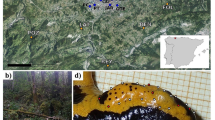Abstract
The population density and demography of five species of arctic Collembola were studied in a naturally patchy habitat, consisting of Carex ursinae tussocks with varying degrees of isolation. Focal predictor variables were those describing the spatial configuration of tussocks, including tussock size and isolation and the amount of habitat (cover) at a 1-m2 scale surrounding each tussock population. The Collembola populations were heavily influenced by environmental stochasticity in the form of winter mortality and summer drought, and the influence of patchiness on population characteristics was evaluated in this context. The five species showed very different responses to the structuring effect of the habitat, depending on life history characteristics, mobility and habitat requirements. Population density was highly variable in both time and space. Spring densities indicated larger winter mortality compared to observations from a previous study, and the snow- and ice-free season from June to August only resulted in population growth for Folsomia sexoculata. In the other species, adult mortality must have been high as there was no net population growth despite observed reproduction. The exception was Hypogastrura viatica, whose population decline was more likely to have been the result of migration out of the study area. Cover was the most important variable explaining density. No pure area or isolation effects at the tussock level were detected, even in areas with very low habitat cover. Drought was probably an important mortality factor, as July was particularly warm and dry. Due to qualitative differences in the tussocks and the matrix substrate, desiccation risk would be higher during dispersal between tussocks. We suggest that increased dispersal mortality gave the observed pattern of increased density in relation to cover, both in general and in F. quadrioculata, an opportunistic species otherwise known for rapid population growth. Onychiurus groenlandicus, which had a similar density response to cover, may also be influenced by a rescue effect sustaining densities in areas with high cover. The cover effect can be viewed as a large-scale factor which encompasses the general spatial neighbourhood of each tussock, where inter-population processes are important, as opposed to internal patch dynamics.
Similar content being viewed by others
Author information
Authors and Affiliations
Additional information
Received: 15 March 1999 / Accepted: 22 March 2000
Rights and permissions
About this article
Cite this article
Hertzberg, K., Yoccoz, N., Ims, R. et al. The effects of spatial habitat configuration on recruitment, growth and population structure in arctic Collembola. Oecologia 124, 381–390 (2000). https://doi.org/10.1007/s004420000398
Issue Date:
DOI: https://doi.org/10.1007/s004420000398




